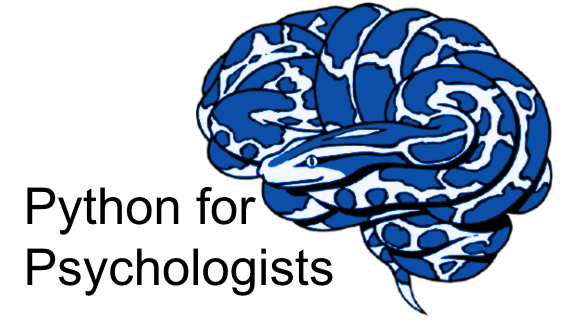Experimentation I - Introduction to PsychoPy I
Contents
Experimentation I - Introduction to PsychoPy I¶
Peer Herholz (he/him)
Habilitation candidate - Fiebach Lab, Neurocognitive Psychology at Goethe-University Frankfurt
Research affiliate - NeuroDataScience lab at MNI/McGill
Member - BIDS, ReproNim, Brainhack, Neuromod, OHBM SEA-SIG, UNIQUE
![]()
![]() @peerherholz
@peerherholz
Objectives 📍¶
get to know the PsychoPy library
learn basic and efficient usage of its
modules andfunctions to create simple experiments
Important note¶
The main content of this section will be presented via a mixture of slides and VScode which is further outlined in the respective section of the course website and slides. As noted there, jupyter notebooks aren’t the best way to work on and run experiments using PsychoPy, instead we need to switch to IDEs for this part of the course. Specifically, we will use VScode for this.

This notebook is thus not intended as the main resource and you shouldn’t try to test/run the experiment via the here included code cells. Rather, this is meant to be an add-on resource that presents some of the content and especially code in a more condensed form. We hope it will be useful/helpful for you.
Outline¶
Within this notebook we will go through the basic and required steps to create a new experiment using PsychoPy, including:
Prerequisites
1.1 Computing environment
1.2 Folders & FilesPsychoPybasics
2.1 The general idea
2.2 Input viadialog boxes
2.3 Presenting instructionsPsychoPy’s working principles
3.1drawing &flipping
3.2trialsInput/output
4.1 collecting responses
4.2 saving dataA very simple experiment
Prerequisites¶
Starting new experiments in PsychoPy follows the same guidelines as starting new projects in general. This includes the following:
create and store everything in a dedicated place on your machine
create and use a dedicated computing environment
document everything or at least as much as possible
test and save things in very short intervals, basically after every change

Computing environments¶
As addressed during the first weeks of the course, computing environments are essential when programming, not only in Python. This refers to reproducibility, transfer/sharing of code and many other factors. Lucky for us Python makes it easy to create and manage computing environments, for example using conda.
We can thus also use it to create a new computing environment specifically dedicated to creating and running a new experiment using PsychoPy. Here we will name it psychopy and include/install a few dependencies we already know:
%%bash
conda create -n psychopy psychopy
conda activate psychopy
pip install jedi psychtoolbox pygame pyo pyobjc
python-vlc ujson
With these few steps we have our (initial) computing environment ready to go!
Let’s continue with creating folders and files we need.
Folders & files¶
As mentioned above, it’s a good idea to keep things handy and organized. Obviously, this also holds true for running experiments using PsychoPy. While there are several ways we could do this, at the minimum we need a dedicated folder or directory somewhere on our machine within which we will store all corresponding information and files. Creating a new directory as no biggie using bash, we can simply use mkdir and specify the wanted path and name. For the sake of simplicity, let’s put everything in a folder called psychopy_experiment on our Desktops.
%%bash
mkdir /path/to/your/Desktop/psychopy_environment
Now we will change our current working directory to this new folder
%%bash
cd /path/to/your/Desktop/psychopy_environment
and once there, create a new python script, i.e. an empty python file. For this we can use bashs touch function followed by the desired filename. Keeping things simple again, we will name it experiment.py (notice the file extension .py).
%%bash
touch experiment.py
Within this, currently empty, python file/script we will put our python code needed to run the experiment.
VScode setup¶
Once more: please remember that we’re switching to an IDE for this part of the course, specifically VScode, as jupyter notebooks aren’t the most feasible way to implement/test/run experiments via PsychoPy. Therefore, please open VScode and within it open the folder we just created (File -> Open Folder). Next, click on the experiment.py file which should open in the editor window and finally also open a terminal via Terminal -> New Terminal and activate the computing environment we created above. With that your setup is ready for our PsychoPy adventure and should look roughly like below:
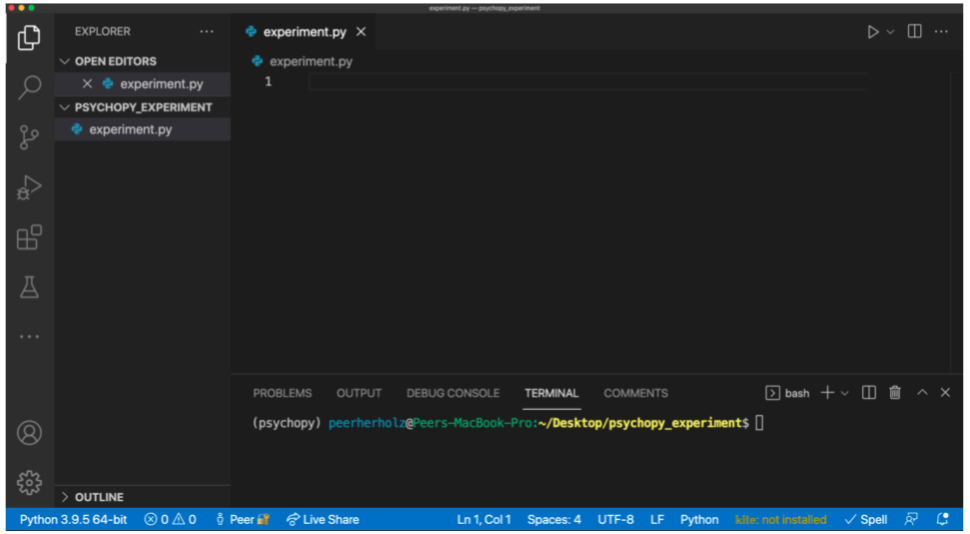
PsychoPy basics¶
It’s already time to talk about PsychoPy, one of the python libraries intended to run experiments and acquire data. For more information regarding different software and options, their advantages and drawbacks, please consult the slides.

Make sure to check the PsychoPy website, documentation and forum.
What is PsychoPy¶
Psychology software in
Python, i.e. aPython library, i.e. completely written inPython2002-2003: Jon Pierce began work on this for his own lab (visual neuroscience)
2003-2017: a purely volunteer-driven, evenings and weekends project
2017-now: still open source and free to install but with professional support
Idea/goals of PsychoPy¶
allow scientists to run as wide a range of experiments as possible, easily and via standard computer hardware
precise enough for psychophysics
intuitive enough for (undergraduate) psychology (no offence)
flexible enough for everything else
capable of running studies in the lab or online
Things to check/evaluate¶
computer hardware settings & interfaces
rapid software development
always check version
set
versioninexperimentuse
environmentsforexperimentsdon’t change version in running
experiments
First things first: do you have a working PsychoPy installation?
We can simply check that via starting an ipython session from our terminal:
%%bash
ipython
and from within there then try importing PsychoPy:
import psychopy
The general idea¶
If you don’t get an import error, at least the basic installation should be ok!
Cool, we are now ready to actually do some coding! As said before we will do that in our experiment.py script. While the transition from jupyter notebooks to python scripts might seem harsh at first, it’s actually straight-forward: the steps we conducted/commands we run in an incremental fashion will also be indicated/run in an incremental fashion here, just within one python script line-by-line.
So, what’s the first thing we usually do? That’s right: importing modules and functions we need. Comparably to jupyter notebook, we will do that at the beginning of our script. Please note, that we will go through a realistic example of coding experiments in python and thus might not all modules/functions we will actually need when we start. Thus, we will add them at the beginning as we go along!
However, we actually haven’t checked out what modules/functions PsychoPy has. Let’s do that first.
psychopy.core: various basic functions, including timing & experiment termination
psychopy.gui: various basic functions, including timing & experiment termination
psychopy.event: handling of keyboard/mouse/other input from user
psychopy.visual/sound: presentation of stimuli of various types (e.g. images, sounds, etc.)
psychopy.data: handling of condition parameters, response registration, trial order, etc.
many more …: we unfortunately can’t check out due to time constraints
Nice, looks like a decent collection of useful/feasible modules/functions. The question now is: which ones do we need to implement and run our experiment? Wait a minute…we genuinely didn’t even talk about the experiment yet…
Let’s assume we have obtained some data regarding favorite movies, snacks and animals from a group of fantastic students (obviously talking about you rockstars!) and now want to test how each respectively provided item is perceived/evaluated by our entire sample: how would we do that?
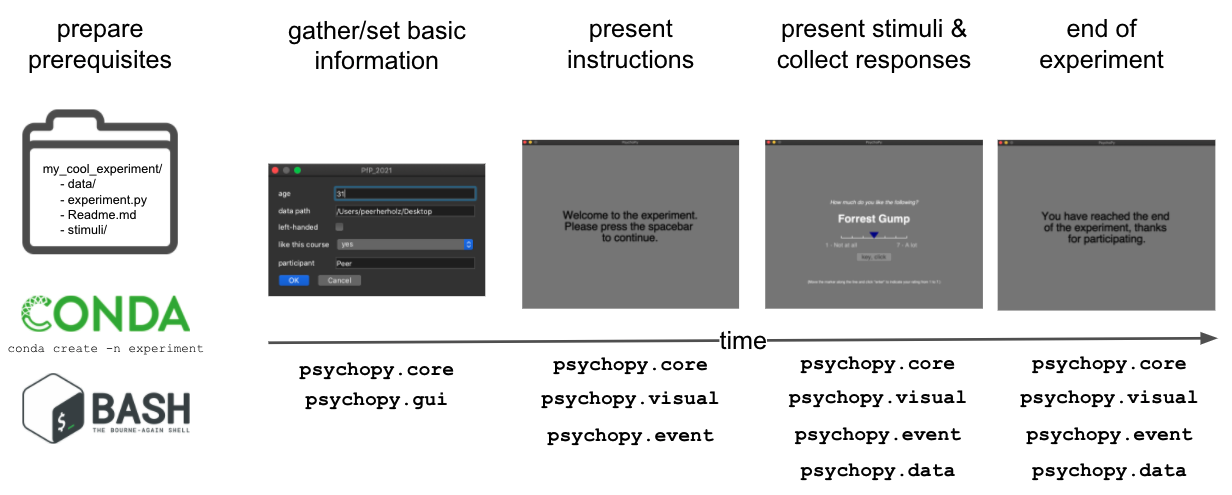
As you can see, we need all of them!
Input via dialog boxes¶
Many experiments start with a GUI dialog box that allow users/participant to input certain information, for example participant id, session, group, data storage path, etc. . We can implement this crucial aspect via the psychopy.gui module. Initially, we need to import it and thus need to start a new section in our python script and after that, we can define the GUI dialog box we want to create via a dictionary with respective key-value pairs.
Please note: at this we will start populating our experiment.py script. Thus, you should copy paste the respective content of the code cells into your experiment.py script you opened in VScode. As we will go step-by-step, the code/script will get longer and longer.
#===============
# Import modules
#===============
from psychopy import gui, core # import psychopy modules/functions
#========================================
# Create GUI dialog box for user input
#========================================
# Get subject name, age, handedness and other information through a dialog box
exp_name = 'PfP_2021' # set experiment name
exp_info = {
'participant': '', # participant name as string
'age': '', # age name as string
'left-handed':False, # handedness as boolean
'like this course':('yes', 'no'), # course feedback as tuple
'data path': '', # data path as string
}
dlg = gui.DlgFromDict(dictionary=exp_info, title=exp_name) # create GUI dialog box from dictionary
# If 'Cancel' is pressed, quit experiment
if dlg.OK == False:
core.quit()
That’s actually all we need to test our GUI dialog box. In order to do that, we need to run/execute our python script called experiment.py. This is achieved via typing python experiment.py in the VScode terminal and pressing enter this will run/execute the python script experiment.py via the python installed in our conda environment called psychopy. Again, please don’t run/execute code in this jupyter notebook!
python experiment.py
If everything works/is set correctly you should see a GUI dialog box appearing on your screen asking for the information we indicated in our experiment.py python script (chances are the layout on your end looks a bit different than mine, that’s no biggie). After entering all requested information and clicking ok the GUI dialog box should close and no errors should appear.
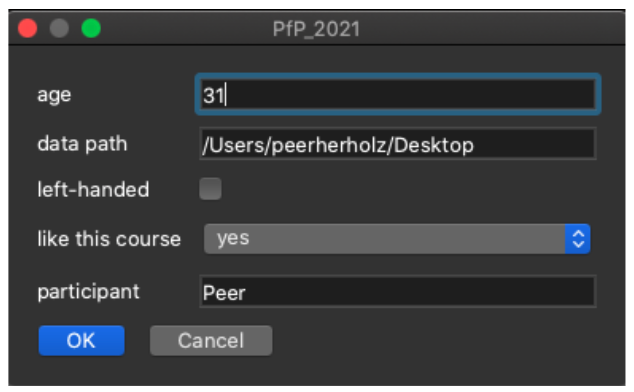
The next aspect we should take care of is the data handling, i.e. defining a data filename and path where it should be saved. We can make use of the exp_info dictionary right away and extract important information from there, for example, the experiment name and participant ID. Additionally, we will obtain the date and time via the psychopy.core module. We will also create a unique filename for the resulting data and check if the set data path works out via the os module.
#===============
# Import modules
#===============
from psychopy import gui, core # import psychopy modules/functions
import os # import os module
#========================================
# Create GUI dialog box for user input
#========================================
# Get subject name, age, handedness and other information through a dialog box
exp_name = 'PfP_2021' # set experiment name
exp_info = {
'participant': '', # participant name as string
'age': '', # age name as string
'left-handed':False, # handedness as boolean
'like this course':('yes', 'no'), # course feedback as tuple
'data path': '', # data path as string
}
dlg = gui.DlgFromDict(dictionary=exp_info, title=exp_name) # create GUI dialog box from dictionary
# If 'Cancel' is pressed, quit experiment
if dlg.OK == False:
core.quit()
#=================================================
# Data storage: basic information, filename & path
#=================================================
# Get date and time
exp_info['date'] = data.getDateStr() # get date and time via data module
exp_info['exp_name'] = exp_name # set experiment name
# Check if set data path exists, if not create it
if not os.path.isdir(exp_info['data path']):
os.makedirs(exp_info['data path'])
# Create a unique filename for the experiment data
data_fname = exp_info['participant'] + '_' + exp_info['date'] # create initial file name from participant ID and date/time
data_fname = os.path.join(exp_info['data path'], data_fname) # add path from GUI dialog box
Presenting instructions¶
After having set some crucial backbones of our experiment, it’s time to actually start it. Quite often, experiments start with several messages of instructions that explain the experiment to the participant. Thus, we will add a few here as well, starting with a common “welcome” text message. To display things in general but also text, the psychopy.visual module is the way to go. What we need to do now is define a general experiment window to utilize during the entire experiment and a text to be displayed on it.
#===============
# Import modules
#===============
from psychopy import gui, core, visual # import psychopy modules/functions
import os # import os module
#========================================
# Create GUI dialog box for user input
#========================================
# Get subject name, age, handedness and other information through a dialog box
exp_name = 'PfP_2021' # set experiment name
exp_info = {
'participant': '', # participant name as string
'age': '', # age name as string
'left-handed':False, # handedness as boolean
'like this course':('yes', 'no'), # course feedback as tuple
'data path': '', # data path as string
}
dlg = gui.DlgFromDict(dictionary=exp_info, title=exp_name) # create GUI dialog box from dictionary
# If 'Cancel' is pressed, quit experiment
if dlg.OK == False:
core.quit()
#=================================================
# Data storage: basic information, filename & path
#=================================================
# Get date and time
exp_info['date'] = data.getDateStr() # get date and time via data module
exp_info['exp_name'] = exp_name # set experiment name
# Check if set data path exists, if not create it
if not os.path.isdir(exp_info['data path']):
os.makedirs(exp_info['data path'])
# Create a unique filename for the experiment data
data_fname = exp_info['participant'] + '_' + exp_info['date'] # create initial file name from participant ID and date/time
data_fname = os.path.join(exp_info['data path'], data_fname) # add path from GUI dialog box
#===============================
# Creation of window and messages
#===============================
# Open a window
win = visual.Window(size=(800,600), color='gray', units='pix', fullscr=False) # set size, background color, etc. of window
# Define experiment start text
welcome_message = visual.TextStim(win,
text="Welcome to the experiment. Please press the spacebar to continue.",
color='black', height=40)
PsychoPy working principles¶
Here, we came across one of PsychoPy’s core working principles: we need a general experiment window, i.e. a place we can display/present something on. You can define a variety of different windows based on different screens/monitors which should however be adapted to the setup and experiment at hand (e.g. size, background color, etc.). Basically all experiments you will set up will require to define a general experiment window as without it no visual stimuli (e.g. images, text, movies, etc.) can be displayed/presented or how PsychoPy would say it: drawn
Speaking of which: this is the next core working principle we are going to see and explore is the difference between drawing something and showing it.
Drawing & flipping¶
In PsychoPy (and many other comparable software) there’s a big difference between drawing and showing something. While we need to draw something on/in a window that alone won’t actually show it. This is because PsychoPy internally uses “two screens” one background or buffer screen which is not seen (yet) and one front screen which is (currently) seen. When you draw something it’s always going to be drawn on the background/buffer screen, thus “invisible” and you need to flip it to the front screen to be “visible”.
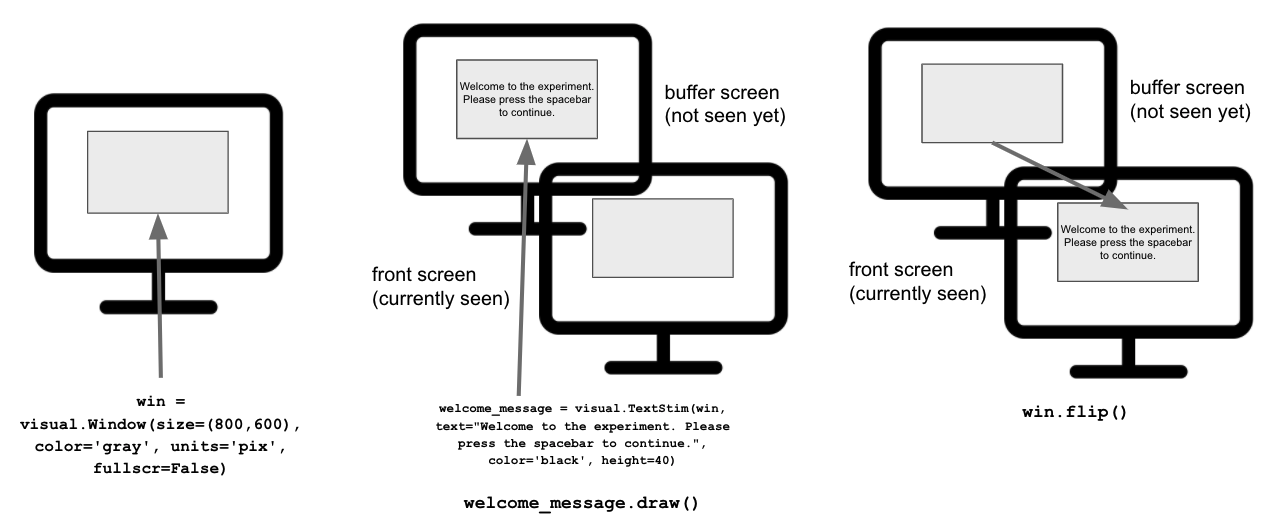
Why does PsychoPy (and other comparable software) work like that? The idea/aim is always the same: increase performance and minimize delays (as addressed in the slides). Drawing something might take a long time, depending on the stimulus at hand, but flipping something already drawn from the buffer to the front screen is fast(er). It can thus ensure better and more precise timing. This can work comparably for images, sounds, movies, etc. where things are set/drawn/pre-loaded and presented exactly when needed.
#===============
# Import modules
#===============
from psychopy import gui, core, visual # import psychopy modules/functions
import os # import os module
#========================================
# Create GUI dialog box for user input
#========================================
# Get subject name, age, handedness and other information through a dialog box
exp_name = 'PfP_2021' # set experiment name
exp_info = {
'participant': '', # participant name as string
'age': '', # age name as string
'left-handed':False, # handedness as boolean
'like this course':('yes', 'no'), # course feedback as tuple
'data path': '', # data path as string
}
dlg = gui.DlgFromDict(dictionary=exp_info, title=exp_name) # create GUI dialog box from dictionary
# If 'Cancel' is pressed, quit experiment
if dlg.OK == False:
core.quit()
#=================================================
# Data storage: basic information, filename & path
#=================================================
# Get date and time
exp_info['date'] = data.getDateStr() # get date and time via data module
exp_info['exp_name'] = exp_name # set experiment name
# Check if set data path exists, if not create it
if not os.path.isdir(exp_info['data path']):
os.makedirs(exp_info['data path'])
# Create a unique filename for the experiment data
data_fname = exp_info['participant'] + '_' + exp_info['date'] # create initial file name from participant ID and date/time
data_fname = os.path.join(exp_info['data path'], data_fname) # add path from GUI dialog box
#===============================
# Creation of window and messages
#===============================
# Open a window
win = visual.Window(size=(800,600), color='gray', units='pix', fullscr=False) # set size, background color, etc. of window
# Define experiment start text
welcome_message = visual.TextStim(win,
text="Welcome to the experiment. Please press the spacebar to continue.",
color='black', height=40)
#=====================
# Start the experiment
#=====================
# display welcome message
welcome_message.draw() # draw welcome message to buffer screen
win.flip() # flip it to the front screen
Let’s give it a try via python experiment.py. If everything works/is set correctly you should see the GUI dialog box again but this time after clicking OK, the text we defined as a welcome message should appear next.
python experiment.py
However, it only appears very briefly and in contrast to our GUI dialog box we don’t need to press anything
to advance. This is because we didn’t tell PsychoPy that we want to wait for a distinct key press before we advance further, we need the psychopy.event module. Through its .waitKeys() function we can define that nothing should happen/we shouldn’t advancing unless a certain key is pressed. While we are at it, let’s add a few more messages to our experiment. One will be presented right after the welcome message and explain very generally what will happen in the experiment. Another one will be presented at the end of the experiment and display a general “that’s it, thanks for taking part” message. The syntax for creating, drawing and presenting these message is identical to the one we just explored, we only need to change the text.
#===============
# Import modules
#===============
from psychopy import gui, core, visual, event # import psychopy modules/functions
import os # import os module
#========================================
# Create GUI dialog box for user input
#========================================
# Get subject name, age, handedness and other information through a dialog box
exp_name = 'PfP_2021' # set experiment name
exp_info = {
'participant': '', # participant name as string
'age': '', # age name as string
'left-handed':False, # handedness as boolean
'like this course':('yes', 'no'), # course feedback as tuple
'data path': '', # data path as string
}
dlg = gui.DlgFromDict(dictionary=exp_info, title=exp_name) # create GUI dialog box from dictionary
# If 'Cancel' is pressed, quit experiment
if dlg.OK == False:
core.quit()
#=================================================
# Data storage: basic information, filename & path
#=================================================
# Get date and time
exp_info['date'] = data.getDateStr() # get date and time via data module
exp_info['exp_name'] = exp_name # set experiment name
# Check if set data path exists, if not create it
if not os.path.isdir(exp_info['data path']):
os.makedirs(exp_info['data path'])
# Create a unique filename for the experiment data
data_fname = exp_info['participant'] + '_' + exp_info['date'] # create initial file name from participant ID and date/time
data_fname = os.path.join(exp_info['data path'], data_fname) # add path from GUI dialog box
#===============================
# Creation of window and messages
#===============================
# Open a window
win = visual.Window(size=(800,600), color='gray', units='pix', fullscr=False) # set size, background color, etc. of window
# Define experiment start text
welcome_message = visual.TextStim(win,
text="Welcome to the experiment. Please press the spacebar to continue.",
color='black', height=40)
# Define trial start text
start_message = visual.TextStim(win,
text="In this experiment you will rate different movies, snacks and animals on a scale from 1 to 7. Please press the spacebar to start.",
color='black', height=40)
# Define experiment end text
end_message = visual.TextStim(win,
text="You have reached the end of the experiment, thanks for participating.",
color='black', height=40)
#=====================
# Start the experiment
#=====================
# display welcome message
welcome_message.draw() # draw welcome message to buffer screen
win.flip() # flip it to the front screen
keys = event.waitKeys(keyList=['space', 'escape']) # wait for spacebar key press before advancing or quit when escape is pressed
# display start message
start_message.draw() # draw start message to buffer screen
win.flip() # flip it to the front screen
keys = event.waitKeys(keyList=['space', 'escape']) # wait for spacebar key press before advancing or quit when escape is pressed
#======================
# End of the experiment
#======================
# Display end message
end_message.draw() # draw end message to buffer screen
win.flip() # flip it to the front screen
keys = event.waitKeys(keyList=['space', 'escape']) # wait for spacebar key press before advancing or quit when escape is pressed
Let’s give it a try via python experiment.py. If everything works/is set correctly you should see the GUI dialog box and after clicking OK, the text we defined as a welcome message should appear next, followed by the start message and finally the end message. In all cases, the experiment should only advance if you press spacebar or quit when you press escape.
python experiment.py
Having this rough frame of our experiment, it’s actually time to add the experiment itself: the evaluation of our movies, snacks and animals.
trials¶
Quick reminder: our experiment should collect responses from participants regarding our lists of movies, snacks and animals, specifically their respective rating. Thus we need to add/implement two aspects in our experiment: the presentation of stimuli and their rating/
Starting with the presentation of stimuli, we will keep it simple for now and present them via text. However, any ideas how we could begin working on this? That’s right: we need to define lists with our stimuli!
movies = [‘Forrest Gump’, ‘Interstellar’, ‘Love Actually’, …]
Within that process, we can already think about the next step: quite often experiments shuffle the order of stimuli across participants to avoid sequence/order effects. We will do the same and implement that via the numpy.random module, specifically its .shuffle() function which will allow us to randomly shuffle our previously created list.
rnd.shuffle(movies)
movies
[‘Interstellar’, ‘Love Actually’, ‘Forrest Gump’, …]
After that we need to bring our shuffled stimuli list into the format required by PsychoPy. Specifically, this refers to the definition of experiment trials, i.e. trials that will be presented during the experiment, including their properties (e.g. content, order, repetition, etc.). In PsychoPy this is achieved via the data.TrialHandler() function for which we need to convert our shuffled stimuli list into a list of dictionaries of the form “stimulus”: value.
stim_order = []
for stim in movies:
stim_order.append({'stimulus': stim})
stim_order
[{‘stimulus’:‘Interstellar’},
{‘stimulus’:‘Love Actually’},
{‘stimulus’:‘Forrest Gump’},…]
The result is then provided as input for the data.TrialHandler() function.
With that we can simply loop over the trials in the trials object and during each iteration draw and flip the respective value of the dictionary key “stimulus” to present the stimuli of our list “movies” one-by-one after one another.
for trial in trials:
# display/draw respective stimulus within each iteration, notice how the stimulus is set "on the fly"
visual.TextStim(win, text=trial['stimulus'], bold=True, pos=[0, 30], height=40).draw()
Additionally, we want to display the question “How much do you like the following?” above the respective stimulus to remind participant about the task. Within each iteration of our for-loop we will also allow participants to quit the experiment by pressing “escape” via the event.getKeys() function as we don’t want to wait for a key to be pressed but want to do something whenever a certain key is pressed.
#===============
# Import modules
#===============
from psychopy import gui, core, visual, event, data # import psychopy modules/functions
import os # import os module
import numpy.random as rnd # import random module from numpy
#========================================
# Create GUI dialog box for user input
#========================================
# Get subject name, age, handedness and other information through a dialog box
exp_name = 'PfP_2021' # set experiment name
exp_info = {
'participant': '', # participant name as string
'age': '', # age name as string
'left-handed':False, # handedness as boolean
'like this course':('yes', 'no'), # course feedback as tuple
'data path': '', # data path as string
}
dlg = gui.DlgFromDict(dictionary=exp_info, title=exp_name) # create GUI dialog box from dictionary
# If 'Cancel' is pressed, quit experiment
if dlg.OK == False:
core.quit()
#=================================================
# Data storage: basic information, filename & path
#=================================================
# Get date and time
exp_info['date'] = data.getDateStr() # get date and time via data module
exp_info['exp_name'] = exp_name # set experiment name
# Check if set data path exists, if not create it
if not os.path.isdir(exp_info['data path']):
os.makedirs(exp_info['data path'])
# Create a unique filename for the experiment data
data_fname = exp_info['participant'] + '_' + exp_info['date'] # create initial file name from participant ID and date/time
data_fname = os.path.join(exp_info['data path'], data_fname) # add path from GUI dialog box
#===============================
# Creation of window and messages
#===============================
# Open a window
win = visual.Window(size=(800,600), color='gray', units='pix', fullscr=False) # set size, background color, etc. of window
# Define experiment start text
welcome_message = visual.TextStim(win,
text="Welcome to the experiment. Please press the spacebar to continue.",
color='black', height=40)
# Define trial start text
start_message = visual.TextStim(win,
text="In this experiment you will rate different movies, snacks and animals on a scale from 1 to 7. Please press the spacebar to start.",
color='black', height=40)
# Define experiment end text
end_message = visual.TextStim(win,
text="You have reached the end of the experiment, thanks for participating.",
color='black', height=40)
#==========================
# Define the trial sequence
#==========================
# Define a list of trials with their properties:
# create empty list
stim_order = []
# convert list into list of dictionaries with key ('stimulus') - value pairing
for stim in movies:
stim_order.append({'stimulus': stim})
# use dictionary to create trials object via data.TrialHandler, specifying further settings
trials = data.TrialHandler(stim_order, nReps=1, extraInfo=exp_info,
method='sequential') # create
#=====================
# Start the experiment
#=====================
# display welcome message
welcome_message.draw() # draw welcome message to buffer screen
win.flip() # flip it to the front screen
keys = event.waitKeys(keyList=['space', 'escape']) # wait for spacebar key press before advancing or quit when escape is pressed
# display start message
start_message.draw() # draw start message to buffer screen
win.flip() # flip it to the front screen
keys = event.waitKeys(keyList=['space', 'escape']) # wait for spacebar key press before advancing or quit when escape is pressed
# Run through the trials, stimulus by stimulus
for trial in trials:
# display/draw task question to remind participants
visual.TextStim(win, text='How much do you like the following?', pos=[0, 90], italic=True).draw()
# display/draw respective stimulus within each iteration, notice how the stimulus is set "on the fly"
visual.TextStim(win, text=trial['stimulus'], bold=True, pos=[0, 30], height=40).draw()
# after everything is drawn, flip it to the front screen
win.flip()
# if participants press `escape`, stop the experiment
if event.getKeys(['escape']):
core.quit()
#======================
# End of the experiment
#======================
# Display end message
end_message.draw() # draw end message to buffer screen
win.flip() # flip it to the front screen
keys = event.waitKeys(keyList=['space', 'escape']) # wait for spacebar key press before advancing or quit when escape is pressed
Let’s give it a try via python experiment.py. If everything works/is set correctly you should see the GUI dialog box and after clicking OK, the text we defined as a welcome message should appear next, followed by the start message. Subsequently, you should see all of our stimuli one after another and the same question above them every trial. Finally, you should see the end message.
python experiment.py
While this is already great, the same thing as during our initial tests with the instruction screens happened: the text, i.e. our stimuli, is only very briefly shown on screen and disappears before we can do anything. That’s because we didn’t specify that we want to collect responses before moving on to the next stimulus yet. We need to add the rating to our experiment, specifically the trials.
Input/output¶
PsychoPy offers quite a bit of possible options to collect responses: simple yes/no questions, rating scales, visual analog scales, voice recordings, etc. and store outputs (files, different levels of detail, etc.).
Collecting responses¶
For the experiment at hand a simple rating scale (yes, a Likert scale to make it Psychology, hehe) should be sufficient. As with the other components we have explored so far, we need to implement/add this via two steps: defining/creating a rating scale and drawing/presenting it.
We can easily define and tweak a rating scale via PsychoPy’s visual.RatingScale() function which allows us to set the range of values, labels, size, etc..
ratingScale = visual.RatingScale(win,
scale = None,
low = 1,
high = 7,
showAccept = True,
markerStart = 4,
labels = ['1 - Not at all', '7 - A lot'],
pos = [0, -80])
We then need to draw it and indicate that we want to wait until a rating was conducted before we advance to the next trial.
while ratingScale.noResponse:
Additionally, we are going to display a small helpful message describing the rating and make sure that the rating scale is reset back to its default status before the next trial starts.
ratingScale.reset()
Even though participants could already perform the rating of the stimuli, we don’t track and collect the respective responses yet. These need to be obtained from the rating scale before we reset it at the end of the trial. As indicated before visual.RatingScale() creates an object/class/data type with many inbuilt functions, this includes .getRating() and .getRT() to collect the provided rating and corresponding response time:
rating = ratingScale.getRating()
rt = ratingScale.getRT()
We can then store both values per trial in the trials object via its .addData() function:
trials.addData('rt', rt)
trials.addData('rating', rating)
#===============
# Import modules
#===============
from psychopy import gui, core, visual, event, data # import psychopy modules/functions
import os # import os module
import numpy.random as rnd # import random module from numpy
#========================================
# Create GUI dialog box for user input
#========================================
# Get subject name, age, handedness and other information through a dialog box
exp_name = 'PfP_2021' # set experiment name
exp_info = {
'participant': '', # participant name as string
'age': '', # age name as string
'left-handed':False, # handedness as boolean
'like this course':('yes', 'no'), # course feedback as tuple
'data path': '', # data path as string
}
dlg = gui.DlgFromDict(dictionary=exp_info, title=exp_name) # create GUI dialog box from dictionary
# If 'Cancel' is pressed, quit experiment
if dlg.OK == False:
core.quit()
#=================================================
# Data storage: basic information, filename & path
#=================================================
# Get date and time
exp_info['date'] = data.getDateStr() # get date and time via data module
exp_info['exp_name'] = exp_name # set experiment name
# Check if set data path exists, if not create it
if not os.path.isdir(exp_info['data path']):
os.makedirs(exp_info['data path'])
# Create a unique filename for the experiment data
data_fname = exp_info['participant'] + '_' + exp_info['date'] # create initial file name from participant ID and date/time
data_fname = os.path.join(exp_info['data path'], data_fname) # add path from GUI dialog box
#===============================
# Creation of window and messages
#===============================
# Open a window
win = visual.Window(size=(800,600), color='gray', units='pix', fullscr=False) # set size, background color, etc. of window
# Define experiment start text
welcome_message = visual.TextStim(win,
text="Welcome to the experiment. Please press the spacebar to continue.",
color='black', height=40)
# Define trial start text
start_message = visual.TextStim(win,
text="In this experiment you will rate different movies, snacks and animals on a scale from 1 to 7. Please press the spacebar to start.",
color='black', height=40)
# Define experiment end text
end_message = visual.TextStim(win,
text="You have reached the end of the experiment, thanks for participating.",
color='black', height=40)
#==========================
# Define the trial sequence
#==========================
# Define a list of trials with their properties:
# create empty list
stim_order = []
# convert list into list of dictionaries with key ('stimulus') - value pairing
for stim in movies:
stim_order.append({'stimulus': stim})
# use dictionary to create trials object via data.TrialHandler, specifying further settings
trials = data.TrialHandler(stim_order, nReps=1, extraInfo=exp_info,
method='sequential') # create
#================================
# Define a rating scale
#================================
ratingScale = visual.RatingScale(win,
scale = None, # This makes sure there's no subdivision on the scale
low = 1, # This is the minimum value I want the scale to have
high = 7, # This is the maximum value of the scale
showAccept = True, # This shows the user's chosen value in a window below the scale
markerStart = 4, # This sets the rating scale to have its marker start on 5
labels = ['1 - Not at all', '7 - A lot'], # This creates the labels
pos = [0, -80]) # set the position of the rating scale within the window
#=====================
# Start the experiment
#=====================
# display welcome message
welcome_message.draw() # draw welcome message to buffer screen
win.flip() # flip it to the front screen
keys = event.waitKeys(keyList=['space', 'escape']) # wait for spacebar key press before advancing or quit when escape is pressed
# display start message
start_message.draw() # draw start message to buffer screen
win.flip() # flip it to the front screen
keys = event.waitKeys(keyList=['space', 'escape']) # wait for spacebar key press before advancing or quit when escape is pressed
# Run through the trials, stimulus by stimulus
for trial in trials:
# wait until a rating was conducted before advancing to the next trial
while ratingScale.noResponse:
# display/draw task question to remind participants
visual.TextStim(win, text='How much do you like the following?', pos=[0, 90], italic=True).draw()
# display/draw respective stimulus within each iteration, notice how the stimulus is set "on the fly"
visual.TextStim(win, text=trial['stimulus'], bold=True, pos=[0, 30], height=40).draw()
# display/draw the rating scale
ratingScale.draw()
# display/draw help message regarding rating scale
visual.TextStim(win, text='(Move the marker along the line and click "enter" to indicate your rating from 1 to 7.)',
pos=[0,-200], height=14).draw()
# after everything is drawn, flip it to the front screen
win.flip()
# if participants press `escape`, stop the experiment
if event.getKeys(['escape']):
core.quit()
# get the current rating
rating = ratingScale.getRating()
# get the response time of the current rating
rt = ratingScale.getRT()
# add the current rating to the trials object
trials.addData('rt', rt)
# add the response time of the current rating to the trials object
trials.addData('rating', rating)
# reset the rating scale
ratingScale.reset()
#======================
# End of the experiment
#======================
# Display end message
end_message.draw() # draw end message to buffer screen
win.flip() # flip it to the front screen
keys = event.waitKeys(keyList=['space', 'escape']) # wait for spacebar key press before advancing or quit when escape is pressed
Let’s give it a try via python experiment.py. If everything works/is set correctly you should see the GUI dialog box and after clicking OK, the text we defined as a welcome message should appear next, followed by the start message. Subsequently, you should see all of our stimuli one after another and the same question above them every trial, this time not advancing until you provided a rating. Finally, you should see the end message.
python experiment.py
Our experiment works as expected but we don’t get any output files. The reason is once again simple: we actually didn’t tell PsychoPy that we would like to save our data to an output file. Importantly, our data is stored in the trials object.
Saving data¶
Because things work like a charm and we’re using Python-based tools, the trials object has an in-built function, called .saveAsWideText(), that easily allows this by indicating the desired filename, type and delimiter.
trials.saveAsWideText(data_fname + '.csv', delim=',')
#===============
# Import modules
#===============
from psychopy import gui, core, visual, event, data # import psychopy modules/functions
import os # import os module
import numpy.random as rnd # import random module from numpy
#========================================
# Create GUI dialog box for user input
#========================================
# Get subject name, age, handedness and other information through a dialog box
exp_name = 'PfP_2021' # set experiment name
exp_info = {
'participant': '', # participant name as string
'age': '', # age name as string
'left-handed':False, # handedness as boolean
'like this course':('yes', 'no'), # course feedback as tuple
'data path': '', # data path as string
}
dlg = gui.DlgFromDict(dictionary=exp_info, title=exp_name) # create GUI dialog box from dictionary
# If 'Cancel' is pressed, quit experiment
if dlg.OK == False:
core.quit()
#=================================================
# Data storage: basic information, filename & path
#=================================================
# Get date and time
exp_info['date'] = data.getDateStr() # get date and time via data module
exp_info['exp_name'] = exp_name # set experiment name
# Check if set data path exists, if not create it
if not os.path.isdir(exp_info['data path']):
os.makedirs(exp_info['data path'])
# Create a unique filename for the experiment data
data_fname = exp_info['participant'] + '_' + exp_info['date'] # create initial file name from participant ID and date/time
data_fname = os.path.join(exp_info['data path'], data_fname) # add path from GUI dialog box
#===============================
# Creation of window and messages
#===============================
# Open a window
win = visual.Window(size=(800,600), color='gray', units='pix', fullscr=False) # set size, background color, etc. of window
# Define experiment start text
welcome_message = visual.TextStim(win,
text="Welcome to the experiment. Please press the spacebar to continue.",
color='black', height=40)
# Define trial start text
start_message = visual.TextStim(win,
text="In this experiment you will rate different movies, snacks and animals on a scale from 1 to 7. Please press the spacebar to start.",
color='black', height=40)
# Define experiment end text
end_message = visual.TextStim(win,
text="You have reached the end of the experiment, thanks for participating.",
color='black', height=40)
#==========================
# Define the trial sequence
#==========================
# Define a list of trials with their properties:
# create empty list
stim_order = []
# convert list into list of dictionaries with key ('stimulus') - value pairing
for stim in movies:
stim_order.append({'stimulus': stim})
# use dictionary to create trials object via data.TrialHandler, specifying further settings
trials = data.TrialHandler(stim_order, nReps=1, extraInfo=exp_info,
method='sequential') # create
#================================
# Define a rating scale
#================================
ratingScale = visual.RatingScale(win,
scale = None, # This makes sure there's no subdivision on the scale
low = 1, # This is the minimum value I want the scale to have
high = 7, # This is the maximum value of the scale
showAccept = True, # This shows the user's chosen value in a window below the scale
markerStart = 4, # This sets the rating scale to have its marker start on 5
labels = ['1 - Not at all', '7 - A lot'], # This creates the labels
pos = [0, -80]) # set the position of the rating scale within the window
#=====================
# Start the experiment
#=====================
# display welcome message
welcome_message.draw() # draw welcome message to buffer screen
win.flip() # flip it to the front screen
keys = event.waitKeys(keyList=['space', 'escape']) # wait for spacebar key press before advancing or quit when escape is pressed
# display start message
start_message.draw() # draw start message to buffer screen
win.flip() # flip it to the front screen
keys = event.waitKeys(keyList=['space', 'escape']) # wait for spacebar key press before advancing or quit when escape is pressed
# Run through the trials, stimulus by stimulus
for trial in trials:
# wait until a rating was conducted before advancing to the next trial
while ratingScale.noResponse:
# display/draw task question to remind participants
visual.TextStim(win, text='How much do you like the following?', pos=[0, 90], italic=True).draw()
# display/draw respective stimulus within each iteration, notice how the stimulus is set "on the fly"
visual.TextStim(win, text=trial['stimulus'], bold=True, pos=[0, 30], height=40).draw()
# display/draw the rating scale
ratingScale.draw()
# display/draw help message regarding rating scale
visual.TextStim(win, text='(Move the marker along the line and click "enter" to indicate your rating from 1 to 7.)',
pos=[0,-200], height=14).draw()
# after everything is drawn, flip it to the front screen
win.flip()
# if participants press `escape`, stop the experiment
if event.getKeys(['escape']):
core.quit()
# get the current rating
rating = ratingScale.getRating()
# get the response time of the current rating
rt = ratingScale.getRT()
# add the current rating to the trials object
trials.addData('rt', rt)
# add the response time of the current rating to the trials object
trials.addData('rating', rating)
# reset the rating scale
ratingScale.reset()
#======================
# End of the experiment
#======================
# Save all data to a file
trials.saveAsWideText(data_fname + '.csv', delim=',')
# Display end message
end_message.draw() # draw end message to buffer screen
win.flip() # flip it to the front screen
keys = event.waitKeys(keyList=['space', 'escape']) # wait for spacebar key press before advancing or quit when escape is pressed
If you now try it again, everything should work as before bu after finishing the experiment you should see a new file within the indicated data path containing all information stored about the experiment: trials, stimuli, responses, reaction times, etc. .
A very simple experiment¶
Believe it or not folks, with that we already created our first working PsychoPy experiment. Using only a small amount of, very readable, code, we can obtain ratings for our stimuli. Obviously, this is a very simple experiment but nevertheless a good start, showcasing a lot of the core things you should know to start using PsychoPy for experiments. All the things addressed here are usually also part of much more complex experiments, as well as build their basis.

Outro¶
As usually: awesome work folks! The transition from basic Python aspects to applied together is definitely no cake-walk, especially when simultaneously switching to python scripts from jupyter notebooks but you did a great job!
Thank so much for sticking with us throughout this!

